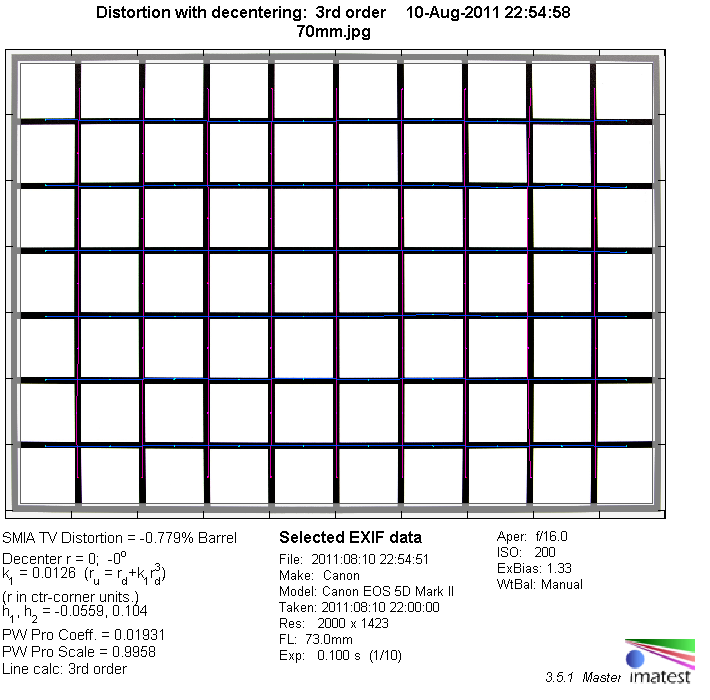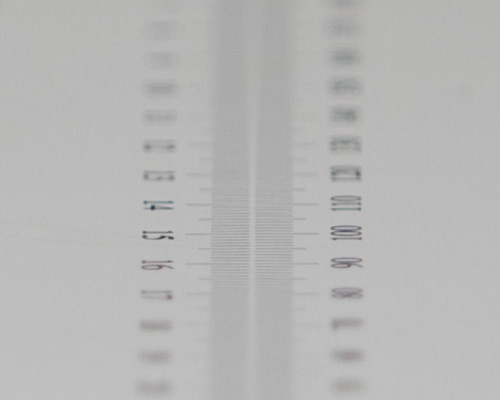|
Canon EF 70-200mm f/2.8 USM L - Full Format Review / Test Report - Analysis |
|
Lens Reviews -
Canon EOS (Full Format)
|
|
Page 2 of 3

Distortion
The Canon lens produces a slight barrel distortion (~0.8%) at 70mm and very slight to moderate (~1.3%) pincushion distortion in the mid to long portion of the zoom range.
|
Move the mouse cursor over the focal length text marks below to observe the respective distortion
|
| 70mm |
135mm |
200mm |
|

|
Vignetting
The vignetting characteristic is about typical for a fast medium tele zoom lens. The light falloff is visible (~0.9EV) at 70mm @ f/2.8 albeit still quite low within the full format scope. Stopping down to f/4 resolves the issue here. The vignetting is somewhat worse at 135mm and 200mm with a light falloff of about ~1.3EV (f-stops) at f/2.8. While still not extreme it will be easily noticeable in several situations unless corrected during post-processing. Stopping down to f/4 tames the issue to a moderate degree and it's negligible beyond.

MTF (resolution)
The resolution capabilities of the Canon lens are impressive although it is stays slightly short of its more "modern" 70-200mm f/2.8 USM L IS II cousin. The lens performs best at 70mm with an excellent center quality straight from f/2.8 and very good borders corners. The quality degrades slightly towards longer focal lengths but this is primarily noticeable at max. aperture only where the center quality falls back to very good results. Even so it remains very sharp across the image frame. Diffraction effects have a higher impact from f/11 onwards but even so the lens remains perfectly usable here.
The centering quality of the tested sample was good.
Please note that the MTF results are not directly comparable across the different systems!
Below is a simplified summary of the formal findings. The chart shows line widths per picture height (LW/PH) which can be taken as a measure for sharpness.
If you want to know more about the MTF50 figures you may check out the corresponding Imatest Explanations
Chromatic Aberrations
Lateral CAs (color shadows at the image borders) have an impact on the subjective quality perception. However, the Canon lens provides a very good performance here. An average CA pixel width of around 1px is not really an issue to worry and that's across the entire zoom range.

Bokeh
Large aperture lenses such as the EF 70-200mm f/2.8 USM L are often used for shallow depth-of-field photography where the quality of the bokeh (out-of-focus blur) is in important criteria. Unfortunately the Canon lens produces an Okayish bokeh for a zoom lens.
Out-of-focus highlights have a circular shape at f/2.8 but that's only in the (broader) image center. The shape deteriorates towards "cat's eyes" in the outer zones (max. aperture only). There's a slight outlining effect at the highlight edges. However, stopping down produces an edgy highlight rendition which is typical for lenses without rounded aperture blades.
 The quality of the general blur is smooth in the foreground (shown to the left below) but nervous in the more critical background portion (to the right).
The quality of the general blur is smooth in the foreground (shown to the left below) but nervous in the more critical background portion (to the right).

Bokeh Fringing / Longitudinal Chromatic Aberrations (LoCA)
The term bokeh fringing refers to the purple to greenish colors in the focus transitions zones. The effect is also present in images taken with the Canon lens. It is most pronounced albeit not extreme at f/2.8 but already reduced at f/4 and not really relevant anymore beyond.
|
Move the mouse cursor over the f-stop marks below to observe the respective LoCAs
|
| f/2.8 |
f/4 |
f/5.6 |
|

|
These sample portions were taken at ~140mm.
|